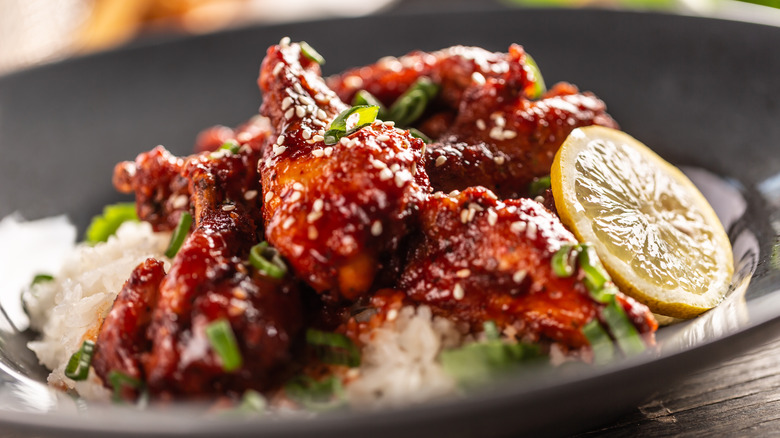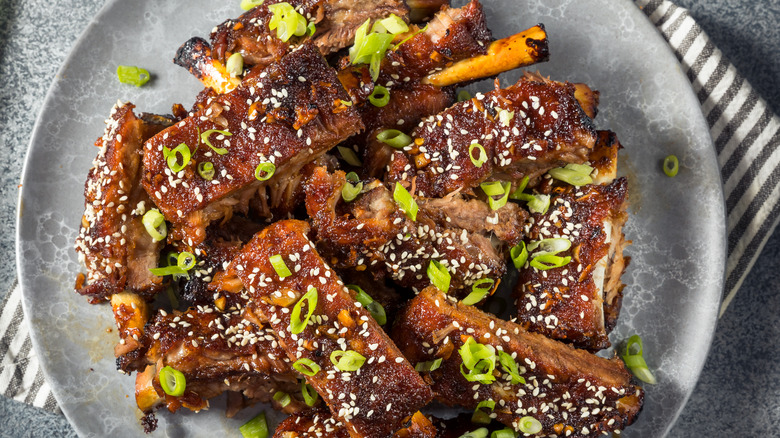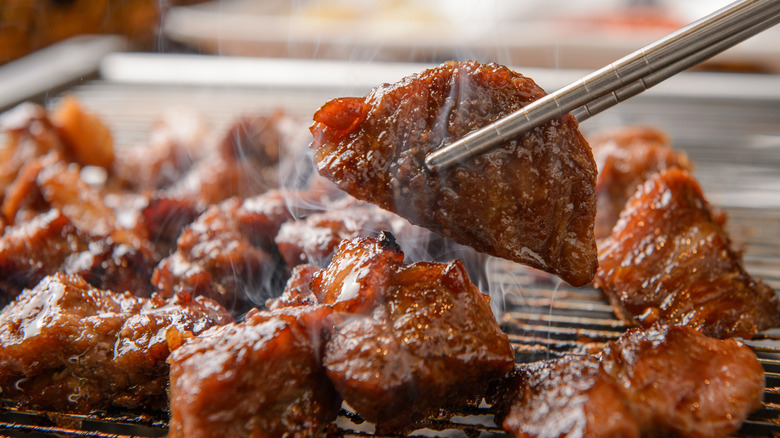What Sets Korean Barbecue Sauce Apart From The American Version
We may receive a commission on purchases made from links.
From the sizzling sound to the tempting aroma, grilled food often makes the stomach grumble before the food hits the plate. While the cooking method itself imparts flavor, barbecue sauce offers another layer of flair. With Korean barbecue sauce, its ingredients create a tanginess and viscosity that are different from its American counterpart.
Korean barbecue sauce uses soy sauce as its base compared to the ketchup in American barbecue sauce. Although both sauces can have sweet notes, the Korean version often has a bold punch of umami. Balancing the acid from apple cider vinegar with the sweetness of Asian pear, this sauce tends to hit all the flavor profiles — yet works well on various proteins.
Another key difference between the two barbecue sauces is their overall thickness. Given that the Korean style is more oil-forward, the liquid is less dense and creamy than the average American-style offering. When cooking with Korean barbecue sauce, the surface almost becomes sticky as it adheres to the food. Generally, the sauce is used more as a marinade prior to cooking, which allows all the salty, sweet, and spicy notes to be absorbed. In addition, the sauce can be brushed onto food during the cooking process. When that tomato based-sauce gets a little bland, it could be time to make a flavorful switch.
Korean barbecue sauce offers cooking versatility
American barbecue sauce is often brushed onto food as it finishes cooking or used as a condiment. With Korean barbecue sauce, it can be used as a marinade, during the cooking process, or as a condiment. That versatility — paired with the layered flavor — makes it a popular choice for beef, pork, and poultry.
Most Korean barbecue sauce recipes contain soy — an ingredient that helps tenderize protein — making them suitable for marinades. For example, the salt component in the soy sauce penetrates the fibers and helps to break them down. While a prolonged soak may not be beneficial, a little time can change the protein's texture.
When used during the cooking process, the sugars and spices in Korean barbecue sauce can help make a satisfying glaze or give a tacky quality to the surface. As the heat hits the sugars, that slight caramelization can seal in and create flavor, similar to a bark on American barbecue. The sauce not only adds flavor but an additional texture to the dish.
Although it could be used as a dipping sauce, Korean barbecue sauce tends to have a more liquid quality. While a little finishing drizzle is nice, it might not necessarily be a dunking scenario.
If those ribs, chicken wings, or even pork medallions need a little flavor twist, consider Korean barbecue sauce as a grilling swap. It might not be an American regional standard, but it's bursting with flavor.
Brands readily available on the shelf
While some people may have the opportunity to sit at a table and enjoy a plate of Korean barbecue at a restaurant, others may prefer to experience those flavors at home. And though creating Korean barbecue sauce from scratch isn't too difficult, some cooks prefer grab a reliable bottled brand. Luckily, there are several that deliver a satisfying option.
Since many people trust Sweet Baby Ray's traditional American barbecue sauces, its Korean-influenced option is quite approachable. Although this sauce might be hard to find outside of food service, sometimes a larger container can be found on Amazon.
Kevin's Gourmet has a Korean Barbecue Sauce and Marinade. Although the description references bulgogi, it can be used on various types of proteins. The touch of lemongrass brings a nice acidic note to the sweetness of the coconut sugars.
The global foods aisle at many grocery stores can be a great resource for these types of sauces. Brands like Lee Kum Kee have authentic options that any cook can easily incorporate into a dish. Since each sauce is different, it is best to look at the ingredients and decide which flavors sound appealing. From there, a little cooking experimentation can narrow the playing field.


